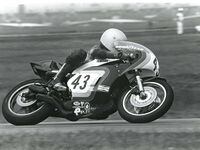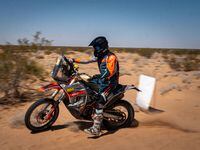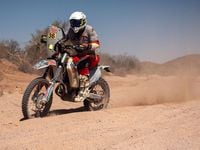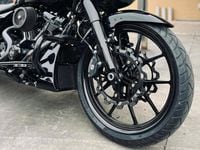A variety of causes can push back a bike’s front-brake caliper pads so that even a full stroke of the lever produces zero braking. Supersport racers are familiar with the accidental combination of a flexy front axle and an episode of wobble. The violent shaking of the front end causes tilting of the wheel between the fork legs, resulting in brake-disc motions that push the pads back into the caliper bodies. When the rider goes for the brakes on approach to the next corner, there is no “lever.”
The generic term for this is pad "knock-off," and Connecticut rider Rich Schlachter experienced it in practice for the 1978 AMA Loudon roadrace national. The bike was a Yamaha TZ750. Fortunately for Schlachter, a quick second pull on the lever produced braking force, so he didn't crash.
What was the cause? One of the checks I had learned to make was to lay a steel straightedge across each brake disc to check for flatness. It showed that both discs were coned, which explained the pad knock-off (the angling of a coned disc in the caliper pushed the pads back).
Why were the discs coned? Loudon and Sears Point—now known as New Hampshire Motor Speedway and Sonoma Raceway—were the two US circuits hardest on brakes. Looking at the pad tracks on the disc faces, it was clear that the outside of the pad track had a greater circumference (distance around) than the inside in the ratio of three to two. And that meant the sliding velocity and the intense heat it generated were 50 percent greater at the disc outside diameter than at the inside of the pad track.
These different heating rates meant the discs were being heated more at their outsides. With Loudon’s heavy braking, the very hot outside edges of the disc were expanding and stretching the inner parts of the disc. When the bike came off the track and the discs cooled, the stretched inner portions of the discs were now too big for the outer portions. As a result, the discs coned.
Today this problem would not occur because motorcycle brake discs have: a) floating mounts that do not oppose disc expansion; and b) brake pads and pad tracks have now been made as narrow as possible to reduce the difference in heating rate between track OD and ID.
But there we were with the equipment we had, stainless-steel discs bolted solidly to aluminum carriers, and they were coned. I could see the words on my silent rider’s face: “Can we fix it for Sunday?”
You must not under any circumstances try what I am about to describe. It was done in emergency conditions to solve a problem that no longer exists. Modifying brake parts is a job for experienced professionals.
We pulled the discs, I put them in my van, and I drove 87 miles back to my shop. What I was about to do carried some risk, but we were out of equipment and time. New discs would cone just as the first set had. Was I going to tell my rider, “See, if you can just brake at 75 percent”? Definitely not. That would be like saying, “Race, but race slowly.”
Back at my shop, I unbolted the discs from their carriers and put a new fine-toothed blade on the band saw. Dividing the discs into equal sectors, I drew six radial lines on each with a fine-point magic marker. Then I drilled a quarter-inch hole through the disc at the inner end of each line. And then I made radial saw cuts that ended in those holes; the holes were there to reduce stress at the inner end of each saw cut.
The discs immediately became flat because the cuts had relieved the hoop tension in the contracted outer parts of the discs. Why did I think this would work? Years before, in somebody’s dim-lit basement, I had seen clutch plates with such radial cuts in them. When I asked about them, I’d been told, “Yeah, those old Norton clutch plates used to cone up if you used ’em real hard. The saw cuts made ’em lay flat again.”
Next I deburred the sharp edges of my saw cuts so they would slide easily through the brake pads. And I reassembled the discs on their carriers, all the while worrying that if somehow one disc sector deflected enough, it could hit the edge of a pad or even the caliper itself, locking the front wheel.
Early next morning I was on the road to the track—McDonald’s breakfast in Keene, New Hampshire—and in first practice our brakes worked perfectly. The discs were getting very hot, but they no longer coned. And I was still nervous about them.
Later, I saw factory teams had been driven to the same extreme by the same problem. This had been an emergency step on the way to better brakes. Over time, brake engineers soon saw that floating disc mounting had become necessary and narrower friction pad tracks would reduce the OD-to-ID difference in heating rate.
To make those narrower pad tracks possible, four-piston calipers soon took the place of the previous “Big Bertha” round-pad two-piston calipers of the early disc-brake era (those Yamaha pads were a full 2 inches in diameter!). That’s why today’s brake pads distribute their area differently, being radially narrow but longer in the direction of disc motion. The result is improved fitness for purpose.
Schlachter was third on Sunday.














/cloudfront-us-east-1.images.arcpublishing.com/octane/RGUT3Y65IFGDFMLHQ3U7G5UUQE.jpg)

/cloudfront-us-east-1.images.arcpublishing.com/octane/37CSHD6CKRHYXHRB67EOLDS6XM.jpg)
/cloudfront-us-east-1.images.arcpublishing.com/octane/FYB7GKDGLVE3JKXMM75JTG2RYA.jpg)
/cloudfront-us-east-1.images.arcpublishing.com/octane/3ECVMM622VAZHIOLI6Q6ILWULU.jpg)


/cloudfront-us-east-1.images.arcpublishing.com/octane/UIZQ7VXRCRHBVDFK5RFJIEBBAU.jpg)

/cloudfront-us-east-1.images.arcpublishing.com/octane/QXBJ4CVEEBG2BF5O3TOPIGP7ZE.jpg)


/cloudfront-us-east-1.images.arcpublishing.com/octane/HGNDJUKK4FHNTP5XEYYHWVW6NI.jpg)
/cloudfront-us-east-1.images.arcpublishing.com/octane/GDGQOIQBDBCXLIUZUEMCP2C5ZE.jpg)
/cloudfront-us-east-1.images.arcpublishing.com/octane/M6Z3IHJEAZE4XDQGCFN7YPJEOA.jpg)
/cloudfront-us-east-1.images.arcpublishing.com/octane/L6GYTNOQB5FOXPUZIQZYQSJ3PI.jpg)
/cloudfront-us-east-1.images.arcpublishing.com/octane/FCGZHQXRBZFLBAPC5SDIQLVF4I.jpg)
/cloudfront-us-east-1.images.arcpublishing.com/octane/CWPFD2XJ6VHSJK3YMIJGHRJ5SA.jpg)
/cloudfront-us-east-1.images.arcpublishing.com/octane/4TTNZVVO6ZGN7AQUHVGHM4NFLQ.jpg)
/cloudfront-us-east-1.images.arcpublishing.com/octane/RXDCXNV46VFEVM4FNKCBPCTQXE.jpg)
/cloudfront-us-east-1.images.arcpublishing.com/octane/IM3CJCUTHRHXFCJG77O4OCEBII.jpg)
/cloudfront-us-east-1.images.arcpublishing.com/octane/PHTL3AYR4NBHTDGG5IPVQLJJIQ.jpg)
